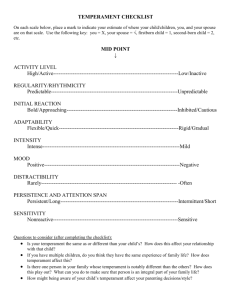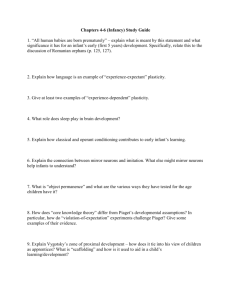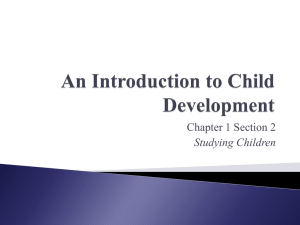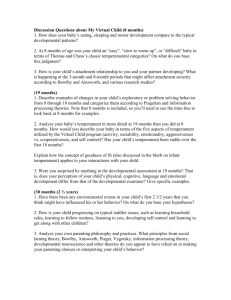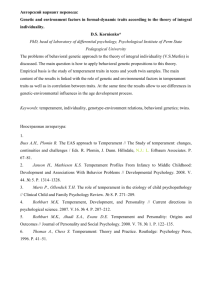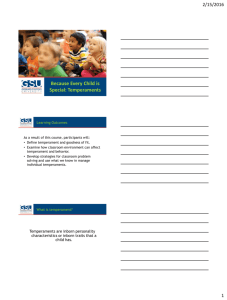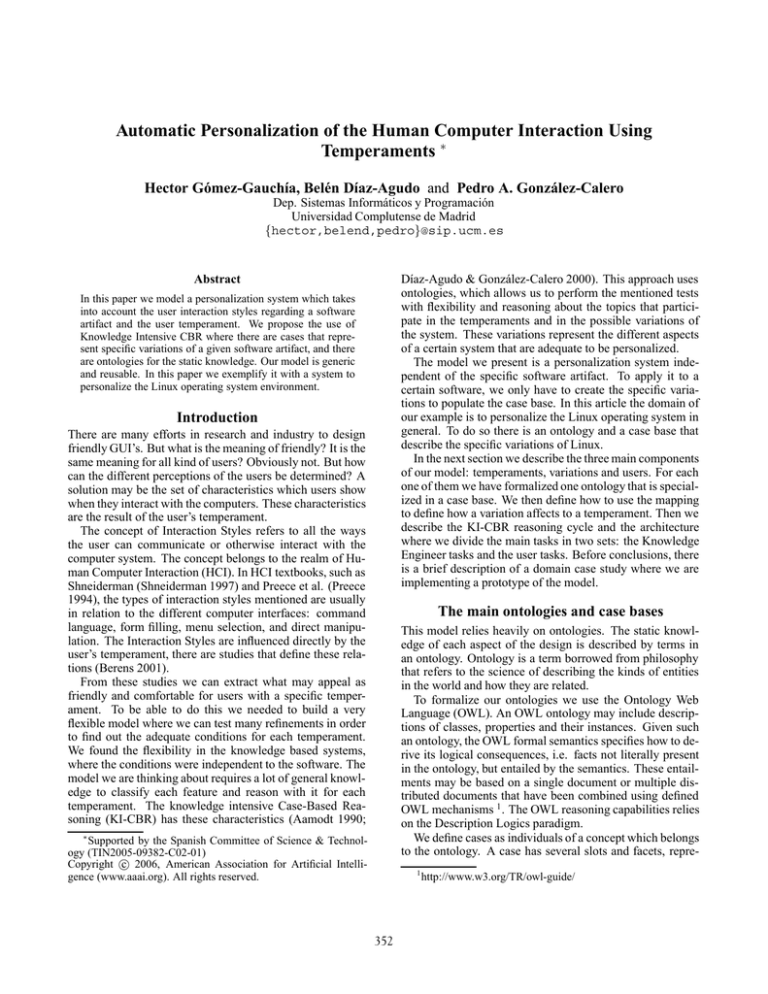
Automatic Personalization of the Human Computer Interaction Using
Temperaments ∗
Hector Gómez-Gauchı́a, Belén Dı́az-Agudo and Pedro A. González-Calero
Dep. Sistemas Informáticos y Programación
Universidad Complutense de Madrid
{hector,belend,pedro}@sip.ucm.es
Dı́az-Agudo & González-Calero 2000). This approach uses
ontologies, which allows us to perform the mentioned tests
with flexibility and reasoning about the topics that participate in the temperaments and in the possible variations of
the system. These variations represent the different aspects
of a certain system that are adequate to be personalized.
The model we present is a personalization system independent of the specific software artifact. To apply it to a
certain software, we only have to create the specific variations to populate the case base. In this article the domain of
our example is to personalize the Linux operating system in
general. To do so there is an ontology and a case base that
describe the specific variations of Linux.
In the next section we describe the three main components
of our model: temperaments, variations and users. For each
one of them we have formalized one ontology that is specialized in a case base. We then define how to use the mapping
to define how a variation affects to a temperament. Then we
describe the KI-CBR reasoning cycle and the architecture
where we divide the main tasks in two sets: the Knowledge
Engineer tasks and the user tasks. Before conclusions, there
is a brief description of a domain case study where we are
implementing a prototype of the model.
Abstract
In this paper we model a personalization system which takes
into account the user interaction styles regarding a software
artifact and the user temperament. We propose the use of
Knowledge Intensive CBR where there are cases that represent specific variations of a given software artifact, and there
are ontologies for the static knowledge. Our model is generic
and reusable. In this paper we exemplify it with a system to
personalize the Linux operating system environment.
Introduction
There are many efforts in research and industry to design
friendly GUI’s. But what is the meaning of friendly? It is the
same meaning for all kind of users? Obviously not. But how
can the different perceptions of the users be determined? A
solution may be the set of characteristics which users show
when they interact with the computers. These characteristics
are the result of the user’s temperament.
The concept of Interaction Styles refers to all the ways
the user can communicate or otherwise interact with the
computer system. The concept belongs to the realm of Human Computer Interaction (HCI). In HCI textbooks, such as
Shneiderman (Shneiderman 1997) and Preece et al. (Preece
1994), the types of interaction styles mentioned are usually
in relation to the different computer interfaces: command
language, form filling, menu selection, and direct manipulation. The Interaction Styles are influenced directly by the
user’s temperament, there are studies that define these relations (Berens 2001).
From these studies we can extract what may appeal as
friendly and comfortable for users with a specific temperament. To be able to do this we needed to build a very
flexible model where we can test many refinements in order
to find out the adequate conditions for each temperament.
We found the flexibility in the knowledge based systems,
where the conditions were independent to the software. The
model we are thinking about requires a lot of general knowledge to classify each feature and reason with it for each
temperament. The knowledge intensive Case-Based Reasoning (KI-CBR) has these characteristics (Aamodt 1990;
The main ontologies and case bases
This model relies heavily on ontologies. The static knowledge of each aspect of the design is described by terms in
an ontology. Ontology is a term borrowed from philosophy
that refers to the science of describing the kinds of entities
in the world and how they are related.
To formalize our ontologies we use the Ontology Web
Language (OWL). An OWL ontology may include descriptions of classes, properties and their instances. Given such
an ontology, the OWL formal semantics specifies how to derive its logical consequences, i.e. facts not literally present
in the ontology, but entailed by the semantics. These entailments may be based on a single document or multiple distributed documents that have been combined using defined
OWL mechanisms 1 . The OWL reasoning capabilities relies
on the Description Logics paradigm.
We define cases as individuals of a concept which belongs
to the ontology. A case has several slots and facets, repre-
∗
Supported by the Spanish Committee of Science & Technology (TIN2005-09382-C02-01)
c 2006, American Association for Artificial IntelliCopyright gence (www.aaai.org). All rights reserved.
1
352
http://www.w3.org/TR/owl-guide/
Character: RATIONAL
Communication: abstract
Implementation: utilitarian
DESCRIPTION :
Language: deductive
- Referential: categorical
- Syntactical: subjunctive
- Rhethorical: technical
Intellect: strategic
Directive role: coordinator
- Expresive role: fieldmarshal
- Reserved role: mastermind
Informative role: engineer
- Expresive role: inventor
- Reserved role: architect
Interest
- Education: sciences
- Preoccupation: technology
- Vocation: systems
Orientation
- Present: pragmatism
- Future: skepticism
- Past: relativism
- Place: intersections
- Time: intervals
Self-Image
- Self-Esteem: ingenious
- Self-Respect: autonomous
- Self-Confidence: resolute
Value
- Being: calm
- Trusting: reason
- Yearning: achivement
- Seeking: knowledge
- Prizing: deference
- Aspiring: wizard
Social Role
- Mating: mindmate
- Parenting: individuator
- Leading: visionary
sented as properties and sub-properties. Each of them may
contain individuals of other objects of the same ontology or
other imported ontologies. The advantage of this approach
is that a reasoner may check the consistency and may classify the kind of individuals. We use very narrow ontologies
and cases to simplify the design and updates. This model is
embedded in another model (Gómez-Gauchı́a, Dı́az-Agudo,
& González-Calero 2005), and both share the ontologies and
case bases. This is the reason because the model do not use
some of the classes mentioned in the ontologies.
Temperaments: TEMPonto and the case base
We use the temperament theory (Keirsey 1998), which is
widely applied in psychology and in companies to interview
job candidates. Keirsey’s theory is centered in the long-term
behavior patterns, i.e., what people do. It is an interpretation of the Myers-Briggs and Carl Jung’s writings on personality types. These authors were more interested in what
people think. The theory defines four basic temperaments.
Each person has a unique proportional combination of the
four temperament types. In this article we use an example
where we consider an unique proportional combination as
the description of a new case: Artisan 10 %, Guardian 10
%, Idealist 30 % and Rational 50 %.
Normally one of the temperaments is predominant, rational in the example. This means that the person will behave
most of the time like that temperament.
We describe each temperament type by a set of traits. In
Figure 1 there is a complete set of traits for the rational
temperament. Each trait characterizes the way people behave in relation with a particular aspect. For our example
we consider the trait ”value”, that means what people will
value most in relation with the different aspects of that trait.
The aspects of the ”value” trait are shown in Figure 1. One
of them is being, that means how people appreciate to be.
Rational people value being calm. The word ”calm” is the
value of the aspect ”being”. To represent it in the ontology, shown partially in Figure 2, we create one individual
temp:ValueBeingCalmX of Trait class.
In contrast with the previous example, artisan people
value most being excited. Another example is the trait Language which has a rhetorical aspect. Rational people use a
heterodox kind of rhetorical aspect. In contrast, artisans prefer a technical kind of rhetorical aspect. We believe that if
the model may use different aspects of language adapted to
the language of the user’s temperament, the user will understand better the messages and he will feel more comfortable
working with the system. We personalize the system building variations which affect some specific aspects of a trait.
Figure 1: A basic temperament and its traits
classes that are necessary to define the variation class. Properties names are on top of the text boxes in Figure 2, their are
in thick font in grey color. The main properties of a variation
are:
• affectToTraits has several traits of temperaments which
are affected by the variation. Our variation example has
the temp:ValueBeingCalmX trait.
• hasExecutionSteps are the necessary actions to execute
the variation. In our example we have only one action, ”to
change the background color to green”. The command to
execute it is:
Gconf --set \# 008000
The command is represented by an individual, execStepChangeBackgroundGreen, which belongs to ExecutionStep class (not shown in the figure.) This class has
two main properties:
Variations: VARIonto and the case base
We call variations to all the possible actions that are executed to personalize a domain. For example, in our sample domain, the Linux system, we have the assertion ”the
green color makes you feel calm” which is illustrated in
Figure 2. We create a variation to include this assertion as
a possible personalization action. The variation is an individual GuiLookBackgroundColorTest1 of the variation subclass GUILookBackgroundColor. The ontology has several
– hasActivationCommand has the command to execute
the step, e.g.: ”Gconf” in our example. This is an Linux
utility that changes several aspects of the GUI, depending on the parameters, that is the next property.
– hasActivationParameters the parameters of the command. The parameters are of the ExecParam class that
353
• hasUserType that is the best match of user types.
is explained below.
• hasUserAdaptations with adaptations of that UserType to
the specific user. This property is empty when the UserType Matches exactly or very near with the user’s Temperament proportions. The adaptations are obtained from
the ranges of each variation that were explained in the
VARIonto.
The ExecParam class is specially important for the adaptation of cases. To adapt a case we need a range of flexibility. We get it by the declaration of possible ranges. Each
one refers to one of the basic temperament. In Figure 3 it is
the execParamBackgroundGreenSet individual, which is the
parameter of the ExecutionStep described before. The main
properties of the ExecParam class are (see in Figure 3, thick
font and gray color):
The UserType case represents the unique proportion of
the four basic temperaments and the variations generated
and stored for it. Each case in the case base is one of these
combinations. To avoid an infinite number of cases, a minimum gap between cases is defined a priori. The name of
the example UserType case is UserType-A10-G10-I30-R50.
The main properties are:
• hasExecParamName has the literal name of the parameter
to be executed by the command. In our example ”–set”.
• hasExecParamValue has the value of the param. In our
example is ”#008000”.
• possibleAdaptationRange has four subproperties: idealistRange, artisanRange, rationalRange, guardianRange. It
indicates how strong is the effect for each basic temperament Each one has a list of values. They describe the
distance of the value to that specific temperament. The
first value in the list is the nearest with the strongest effect
and the last value is the farthest with the weakest effect.
An example of the lists is in Figure 3.
• hasTemperamentProportions is the same property as in
the user case.
• hasUserType with the variations for this user type.
Reasoning Cycle
We are using the previous example to illustrate the general
reasoning cycle in our model (Figure 4). We follow the classic CBR cycle (Armengol & Plaza 1994). We query the CBR
system with a description based on a form filled by the user.
Suppose the form gives us the following user temperament
proportions: Artisan 10 %, Guardian 10 %, Idealist 30 %
and Rational 50 %. The reasoning cycle retrieves the most
similar case. Let’s suppose it is Artisan 30 %, Guardian 10
%, Idealist 30 % and Rational 30 %.
To measure the similarity between cases we use the following definition of distance which is a sum of the differences for each of the four temperaments:
• hasExecParamRelevancy indicates the general relative
importance in the adaptation process. It contains the
corresponding four subproperties. Each subproperty is
the relative importance specifically for each temperament. For example, a parameter has a very low value in
guardianRelevancy when it is very little related with that
temperament, e.g.: the background color is not relevant
for guardian people because they do not care much about
colors. This property does not appear in the figure.
Mapping variations into temperaments
T=Rational
å
Each parameter is related with specific traits of the basic
temperaments, not just with the temperament itself. This
relation is by the property affectToTraits of a variation class
that contains traits of the temperament class. This is depicted in Figure 2. For example, the previous example of
background color affects in the value trait of the rational
temperament in a very different way to the artisan temperament. This is because the latter has “artistic” as value in
the selfEsteem trait. This indicates that the artisan people
appreciate the colors from the artistic viewpoint which is
very different to the guardian people that appreciate colors
that produce calm. ValueBeingCalm is an aspect of the trait
”value” represented as a subclass of the ”value”. This is possible because the GuiLookBackgroundColorTest1 variation
of our example has in affectToTraits both traits, ValueBeingCalm and selfEsteemArtistic. And the execution parameters
have different ranges for each of both temperaments.
TArtisan
=
( %NewCaseT - %retrievedCase T ) * CorrectionFactorT
The %NewCase is the proportions of the query. There is
a correction factor that is proportional to the previous difference. The correction factor is very high when the retrieved
case is very far for one of the temperaments with a high percentage, because this retrieved case is not a good case even
if the other percentage temperaments are similar.
The system reuses the retrieved case by adapting the retrieved case output slots, i.e.: a set of variations for each of
the four basic temperaments. Variations are in its own case
base. The adaptation actions are calculated by the difference
between the proportions in the query and in the retrieved
case; in our example the adaptation actions are: make Artisan decreasing 20 %, Guardian stays unmodified, make Rational increasing 20 % and let Idealist without modifications.
After the adaptations, the system executes the modified variations. These variations represent the solved case.
The system performs the adaptation of each variation using the possibleAdaptationRange property that has the possible ranges for each temperament as described before. In
Figure 3 is our variation example; we see in it that the range
for each temperament is a list of values,e.g.: rationalRange.
The total number of values is one hundred percent. To make
User Types and users: USERonto and the case base
In the USERonto there are two kinds of cases, the UserType
and the User. The User case describes the user knowledge
needed by the model and has these main properties:
• hasTemperamentProportions with the percentage of each
of the four basic temperaments.
354
--> The assertion: “the color green makes you feel calm”
VARIonto
TEMPonto
--> Variation: change the background color to Green
->“Rational Temperament
values being calm”
Character: RATIONAL
Communication: abstract
Implementation: utilitarian
DESCRIPTION :
Language: deductive
- Referential: categorical
- Syntactical: subjunctive
- Rhethorical: technical
Intellect: strategic
Directive role: coordinator
- Expresive role: fieldmarshal
- Reserved role: mastermind
Informative role: engineer
- Expresive role: inventor
- Reserved role: architect
Interest
- Education: sciences
- Preoccupation: technology
- Vocation: systems
Orientation
- Present: pragmatism
- Future: skepticism
- Past: relativism
- Place: intersections
- Time: intervals
Self-Image
- Self-Esteem: ingenious
- Self-Respect: autonomous
- Self-Confidence: resolute
Value
- Being: calm
- Trusting: reason
- Yearning: achivement
- Seeking: knowledge
- Prizing: deference
- Aspiring: wizard
Social Role
- Mating: mindmate
- Parenting: individuator
- Leading: visionary
Figure 2: An assertion as a variation related to a specific trait of a temperament
the retrieved case 20 % more rational we calculate that proportion in the list and we choose the element which occupies
the position corresponding to the obtained proportion, i.e.:
50%. This is based in the fact described previously that the
first elements in the list are nearer to the temperament, i.e.:
in our example those first elements are more ”rational”. The
current mood filters the adaptation, increasing or decreasing
some of these adaptations.
The next task is to revise the solved case using the user’s
feedback. The user may agree or complain about the performed variations. If there are complains, the system repairs
the case to create the repaired case.
Once the user agrees with the variations, the result is a
new unique case that is remembered, i.e.: stored in the case
base. To avoid having too many cases that are very similar
each other, the store task is done only if there is at least the
minimum allowed distance between the new case and the
old cases. This threshold keeps a balance between having
to compute a solution from scratch for each new query or
to have thousands of very similar cases stored that would
prevent a good case retrieval performance.
Problem
User’s profile:
-Temperament
-Current mood
RET
RIE
VE
Learnt case
Retrieved
case
It stores the
Repaired
case
(Contents)
Variations:
- GUI
- Speed
Ontologies
EMBER
REM
(Structure)
Description Logics
Set of system
variations for
personalization
Moods
Mapping
.....
Ways of :
- Communicating
- Thinking
- Using time
- Using tools
Case Bases
Repaired
case
Confirmed
solution
RE
USE
Temperament
…
It modifies
the system
variations with
the user
feedback
The Architecture: Main Tasks
Emotions
Solved
case
It executes the
set of system
variations
R E V IS E
Suggested
solution
Figure 4: Overview of the reasoning cycle with ontologies
In this section we briefly explain how we organize our model
in terms of tasks, i.e., pieces of work required to be done and
that are treated as basic units. As it is shown in Figure 5 our
model organizes these tasks into two types: knowledge engineer and user tasks. To solve these tasks our model relies
in the described ontologies, that includes the common vocabulary and general descriptions, and the DLs reasoner.
Solving the knowledge engineering tasks means defining
the ontologies, making the mappings with the specific domain variations and verify them. Once these tasks are solved
the reasoning cycle described previously is in charge of solving the user tasks, composing their results, and performing
the corresponding variations.
User Tasks
• Interviewer The first time user logs in(or when ever he
wants to revise his extended profile), he fills three types
of information:
– a questionnaire. He has two options, a short questionnaire of sixteen questions or a long one of seventy questions. The first one, the so called four type sorter, classifies the user temperament giving a unique proportion
for each of the four basic temperaments. The long one,
the so called temperament sorter II, assigns one of the
355
Figure 3: ExecParam of a variation class and ranges to be adapted
adaptation, the personalizer executes the variations.
3. The personalizer calls the feedbacker task to revise the
solved case. The user may complain about the variations supplying a set of fixes. The personalizer will
modify the solved case variations using the fixes. The
result is the repaired case.
4. The personalizer stores the repaired case, called learnt
case, only if it has the minimum threshold of heuristic
distance to other stored cases. If it does not reach the
threshold, the personalizer stores the fixes as a particular personalization of that user.
sixteen temperaments based on the four pairs of features represented with eight letters. The user may fill
in one of the questionnaires or both. In this last situation the system has more elements to reason more
accurately. In this article we focus on the model that
uses the four basic temperament types.
– Background knowledge topics he fills in the extended
profile are: Computer skills, Domain expertise, ...
– The last topic the interviewer asks is the current mood
or emotional state. There is a set of icons reflecting
several general emotional states such as happy, sad, apathetic, ... or angry. The user may choose the descriptors that better define his current mood.
– After the previous step, or when the user logs into the
system for second time, it asks him to choose a mood
that better fit in his current state.
• Feedbacker This task is optional. The user activates it
when he disagrees with the variations. The user creates
fixes, which indicate which aspects, the variation and its
parameter values, he dislikes and he proposes new ones.
These fixes are passed back to the personalizer.
The result is a query with the description of the user temperament. The personalizer uses it in the CBR cycle.
Knowledge Engineering Tasks
• Personalizer There are two types of personalization:
Manual, where the user chooses the state of each of the
possible variations of the system; Automatic , where the
system reasons to decide the appropriate variations according to the user’s temperament and his current mood.
This is performed by the Case-based reasoning cycle described in the previous section. These are the functional
steps:
• Editor The first task is to build the ontologies and the
case bases. The knowledge engineer describes the model
in terms of classes, properties and its instances. To create
the case bases he uses the ontology terms. The editor uses
a reasoner (Pellet2 or Racer3 ) to verify the consistency
of cases and ontologies. We use Protg as the ontology
editor 4 . The other tasks use the reasoner to classify new
individuals of cases and to update the ontologies and case
bases.
1. The personalizer retrieves the most similar case to the
query. The similarity is an heuristic distance between
the proportions for each temperament of the query and
the description of cases in the case base of users.
2. The personalizer applies the heuristic distance to adapt
the variations of the retrieved case to the description
of the query. The result is the solved case. After the
• Mapper The model is independent to the personalized
domain because the variations are in a separate ontology,
2
http://www.mindswap.org/2003/pellet/index.shtml
http://www.sts.tu-harburg.de/ r.f.moeller/racer/
4
http://protege.stanford.edu/
3
356
Conclusions and Further Work
Knowledge Engineer
Tasks
Since the meaning of friendly GUI is not the same for all
kind of users, we propose to personalize systems based on
characteristics which users show when they interact with
computers. These characteristics are the result of the user’s
temperament.
We propose a model to personalizing software systems
taking into account the user’s temperament. It is independent of the domain and flexible because we use knowledge
based systems to keep separated the knowledge of the domain from the reasoning process. We use the KI-CBR approach to model the static knowledge, which we represent
with ontologies. The core ontologies are: variations of the
system, which are the possible elements to be personalize;
temperaments with traits, which are the aspects of a temperament affected by the variations; and users, which has a
temperament represented by a unique proportion of the four
basic temperaments.
To apply the model to a domain, i.e.: a program or operating system, is only necessary to create the specific variations to populate the case base. In this article we describe
briefly a case study in the domain of Linux personalization.
Currently we are developing a prototype for the Debian distribution and Gnome windows manager.
Editor
Ontologies,
& case bases
VARIonto
Mapper
Variations
case base
Verificator
TEMPonto
User’s Tasks
Interviewer
OWL-DL
Reasoner
temperaments
case base
USERonto
users
case base
Personalizer:
- Automatic
-Manual
Feedbacker
Figure 5: Tasks in the architecture of the model
VARonto. We can put variations of a new domain application in this ontology and exchange the mapping of
VARonto to the temperament ontology. With only these
changes the model will personalize the new domain application. This task is an editor that helps to create the
relations between the variations and the traits affected by
them:
References
– It helps to create a variation.
– It helps to create the temperaments.
– It helps to create the mapping between variation and the
temp.
Aamodt, A. 1990. Knowledge intensive case-based reasoning and sustained learning. In Proceedings of the ninth
European Conference on Artificial Intelligence – (ECAI90), 1–6.
Armengol, E., and Plaza, E. 1994. A knowledge level
model of knowledge based reasoning. In Wess, S.; Althoff,
K. D.; and Richter, M. M., eds., Proceedings of the 1st
European Workshop on Topics in Case-Based Reasoning,
Kaiserslautern, Germany - EWCBR’94. Berlin: Springer–
Verlag. 53–64.
Berens, L. V. 2001. Understanding Yourself and Others:
An Introduction to Interaction Styles. Telos Publications.
Dı́az-Agudo, B., and González-Calero, P. A. 2000. An
architecture for knowledge intensive CBR systems. In
Blanzieri, E., and Portinale, L., eds., Advances in CaseBased Reasoning – (EWCBR’00). Berlin Heidelberg New
York: Springer-Verlag.
Gómez-Gauchı́a, H.; Dı́az-Agudo, B.; and GonzálezCalero, P. 2005. COBBER, Towards an Affective Conversational KI-CBR Framework. In In Proceedings of 2nd
Indian International Conference on Artificial Intelligence.
Keirsey, D. 1998. Please Understand Me II: Temperament
Character Intelligence. Prometheus Nemesis Book Company.
Preece, J. 1994. Human-Computer Interaction. Addison
Wesley.
Shneiderman, B. 1997. Designing the User Interface: 3
edition. Addison Wesley.
The most complex is to decide which traits of which temperament are affected by the variation. We found useful to ask for help to a psychologist. The positive side is
that once this mapping is performed, it is not necessary to
change unless a complain from the feedback is filed.
A case study: personalization of Linux
The main ontologies are created. To applied the model to
the Linux system there are necessary three steps:
• To define and implement a set of variations for Linux.
• A mapping between the set of variations and the temperament ontology to indicate how each variation affects each
temperament trait.
• Define a period of refinement using the feedback of the
users when they do not like the personalization. Our users
are a set of students of the last year of their Degree on
Computer Science.
We are developing a prototype for the Debian distribution
using Gnome as window manager. It allows variations at
several levels of abstraction, from a very detailed level, such
as the ”Gconf” utility of our example, to very generic level,
such as ”themes”. Themes offer a complete unique look for
the Gnome. We create a case base of themes, classify them
according to the traits that affect to the temperaments and
feed them as variations of the system.
357

